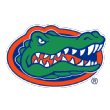
The Florida Gators dropped their final three games of the regular season, but coach Michael White has them back in the NCAA tournament for the third consecutive year. The Gators hope their suffocating defensive pressure carries them deep in the bracket. This is an undersized unit that makes up for its lack of size with speed and skill. Can the Gators find enough offensive firepower to make another March run?
ESPN+ has your answers, as Joe Lunardi has enlisted a team of bracketologists to compile advanced metrics, key scouting intel and best- and worst-case tournament scenarios for all 68 teams to help you make smart picks in your bracket.
TOURNEY PROFILE
Best wins: vs. Ole Miss, at Alabama, at LSU, at Arkansas
Worst losses: Georgia, South Carolina
Regular season conference finish: 8th, SEC
Polls and metrics: BPI ranked the Gators at No. 32 as of March 13 and KenPom had them at No. 31. The NCAA's new NET ranking had Florida at No. 32 in its most recent release.
All-time tourney record: 46-19 (5 Final Fours, 2 national championships)
Coach (tourney record): Mike White (4-2)
PERSONNEL
(Note: Player statistics are through games of March 13.)
Starting lineup
F Kevarrius Hayes (7.8 PPG, 6.1 RPG)
G/F Keyontae Johnson (7.5 PPG, 5.8 RPG)
G Jalen Hudson (8.7 PPG, 2.7 RPG)
G KeVaughn Allen (11.9 PPG, 2.9 RPG)
G Andrew Nembhard (7.9 PPG, 5.2 APG)
Key bench players
F Isaiah Stokes (3.0 PPG, 1.0 RPG)
G Noah Locke (10.2 PPG, 2.5 RPG)
G Mike Okauru (1.5 PPG, 0.6 RPG)
Biggest strength: Defense. The Gators position four perimeter players around one post and hound opponents into turnovers (11.1 steal percentage) and rushed 3-point jumpers (31.6 percent). Florida excels at limiting transition opportunities for opponents and can switch at multiple positions to corral the pick-and-roll half-court sets that fuel so many college attacks. Florida primarily plays man-to-man but will show full-court pressure to keep teams off-balance.
Biggest weakness: Offense. With only two players averaging double-figure scoring, buckets were scarce for long stretches this season. Florida was 220th or worse nationally in 2-point and 3-point field goal percentage. The Gators ended one-fourth of their possessions with a spot-up jump shot but were inefficient in such sets. Locke was the only rotation player who shot better than 36 percent on 3s.
Best player: Allen has been a four-year starter for White, anchoring his initial recruiting class as a top-100 prospect and rewarding the Gators with more than 1,600 career points. Allen wasn't especially efficient this season, hitting 44 percent of 2s and 33 percent of 3s, and must rebound from a late-season shooting slump.
X factor: Hudson. Nobody in the SEC took a higher percentage of his team's shots in conference games this season. The problem? Hudson didn't make many. He hit 26 percent from beyond the arc and fell out of the starting lineup. Still, he has the firepower to change the game, as he proved with a 33-point outburst in an overtime loss to LSU in the final week of the regular season. Hudson is trending upward and that's a good sign for the Gators.
SCOUTING REPORT
How they beat you: Forcing turnovers and making 3-pointers. The Gators mask their lack of size with their perimeter pressure. Freshman point guard Nembhard not only led the team in assists, he's also the best defender. Florida held teams to 48.1 percent effective field goal percentage. The Gators were 10-2 when they shot better than 36 percent from long range. The February win at LSU was a peak for the Gators: They made 11 3-pointers and competed on the defensive glass.
How you beat them: Make it a half-court game and pound the ball inside. Hayes is an excellent post player, but the Gators were porous in the paint, allowing teams to feast on second-chance opportunities, snagging 32 percent of missed shots. Florida's sputtering offense also puts tremendous pressure on the defense to string together stops. The Gators foul frequently and were outscored 394-378 at the free throw line on the season. They were 3-11 when failing to score at least one point per possession.
WHAT THE NUMBERS SAY
(Note: All statistics in this section are courtesy of kenpom.com and are accurate through games of March 13.)
NATIONAL RANKS
Offensive efficiency, 73rd (109.6)
Defensive efficiency, 13th (92.4)
3-point percentage, 224th (33.4)
3-point percentage D, 39th (31.6)
Free throw rate, 277th (29.5)
Free throw rate D, 310th (32.0)
TO percentage, 109th (17.6)
TO percentage D, 11th (23.1)
HOW FAR WILL THEY GO?
Best-case scenario: Second round
Florida's defense is solid enough to push the squad into the round of 32. The rugged SEC schedule, and the variety of styles the Gators faced in the regular season, should have prepared them for the rigors of NCAA tournament play. If Hudson can give Allen and Nembhard scoring help on the perimeter, then Florida can set its full-court pressure after made baskets and create the pace it desires.
Worst-case scenario: One and done
The offense fails to show up as Hudson & Co. drop a ton of bricks and Hayes gets in early foul trouble, exposing the Gators' lack of front-court depth. Florida's inability to score efficiently from the paint, beyond the arc or at the free throw line leads to long stretches of inactivity on the Gators' side of the scoreboard. Florida surrenders multiple point-blank putbacks and digs a deep hole from which it cannot recover.
